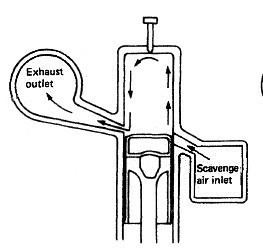 | ||
In automotive usage, scavenging is the process of pushing exhausted gas-charge out of the cylinder and drawing in a fresh draught of air or fuel/air mixture for the next cycle.
Contents
This process is essential in having a smooth-running internal combustion engine. If scavenging is incomplete, the following stroke will begin with a mix of exhaust fumes rather than clean air. This may be inadequate for proper combustion, leading to poor running conditions such as four-stroking.
Scavenging is equally important for both two- and four-stroke engines. However it is more difficult to achieve in two-stroke engines, owing to the proximity, or even overlap, of their induction and exhaust strokes. Scavenging is also equally important to both petrol and diesel engines.
History
The first engines deliberately designed to encourage scavenging were the Crossley 'scavenging engines' designed by Atkinson in the early 1890s. These were soon after Crossley's gas engines had adopted poppet valves rather than their earlier slide valves, which allowed more flexible control over valve timing events. They had exceptionally late exhaust valve closing, over 30° after that of earlier engines, giving a long overlap period when both valves were open together. As these were gas engines they did not require much compression or a long period of valve closure during the compression stroke. To drive the waste gases through the cylinder during this period they assumed the 'vacuum piston' model of exhaust, where a slug of exhaust gas moving down an exhaust pipe was expected to suck further gasses after it. This model assumed that an exhaust pipe needed to be long enough to contain the gas plug for the entire duration of the stroke. As the Crossley engine was so slow-revving, this needed an exhaust pipe of a considerable 65 feet (20 m) between the engine and its cast-iron 'pot' silencer.
Types
There are three types of scavenging on the basis of the flow of air:
Cross flow
This method was used for early crankcase compression two-stroke engines, as used for small motorcycles.
In this method, the transfer port (or inlet port for the engine cylinder) and exhaust port are situated on the opposite sides of the engine cylinder, so that the burnt gases would be pushed out by the cross flow.
The piston crown was usually shaped with a raised rib as a deflector piston, so that the fresh charge was intended to move upwards into a vertical loop, then downwards with the exhaust gas.
In practice, the gasflow failed to follow the idealised pattern. The rib of the deflector piston also gave a poor shape for the combustion chamber, with long flame paths and excessive surface area. This method of scavenging has now been almost entirely replaced by loop scavenging.
Although obsolete for piston-ported two-stroke engines, crossflow scavenging is now very common in four stroke engines, where their inlet and exhaust valves are mounted on opposite sides of the cylinder head. As the inlet and exhaust strokes of the four stroke cycle happen on different strokes of the piston—the upward exhaust stroke, pushing exhaust gases out, is followed by the downward inlet stroke allowing the fresh charge in—the flow is as two isolated single flows, rather than as an unstable loop.
Backflow or loop
Rather than the flow loop being vertical, the gases are encouraged to move in two horizontal loops.
In this method, the inlet and outlet ports are situated on the same side of the engine cylinder. The fresh charge, while entering into the engine cylinder, forms a loop and pushes out the burnt gases.
Uniflow
In this method, the fresh charge, while entering from one side (or sometimes two sides) of the engine cylinder pushes out the gases through the exit valve situated on the top of the cylinder. In uniflow scavenging, both the fresh charge and burnt gases move in the same direction. Usually in diesel type engines the direction of flow is upward but with spark ignition engines such as the Ricardo Dolphin the direction of flow is generally downward with fresh air / fuel entering at the top of the engine.
The uniflow method of scavenging has been widely used for two-stroke diesels, such as the Detroit Diesel Series 53,71,92,110 AND 149 and also the locomotive Electro-Motive Diesel and Cleveland Diesel and used in large 2 stroke ship propulsion engines such as Wärtsilä engines.
Efficiency
Modifying the exhaust system, (i.e. modifying the exhaust gas velocity by changing exhaust tube diameters) can detract from the "ideal" scavenging effects, and reduce fuel efficiency and power if not properly planned out and executed.
To increase scavenging potential, the entire path from intake to exhaust to tailpipe must be tuned and in sync with itself. This will ensure that the air flow is never interrupted. The acceleration and deceleration of this exhaust gas is what will hinder the scavenging potential.
For example, fast flowing heads and a tunnel ram intake combined with a poorly planned camshaft and exhaust system will cause the air to "slow down" and "speed up" throughout its journey, thus reducing its scavenging potential. So, to increase scavenging potential, the air must maintain a positive linear acceleration curve.
